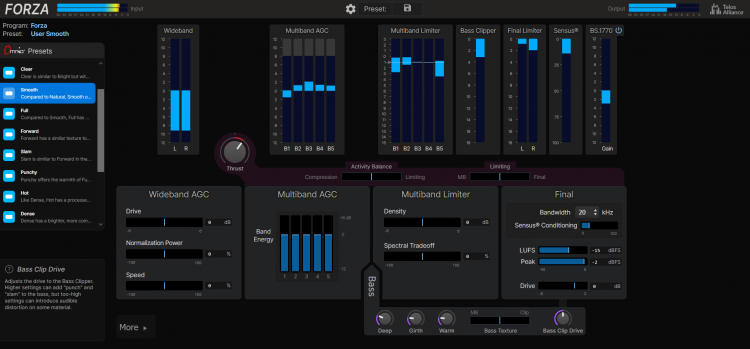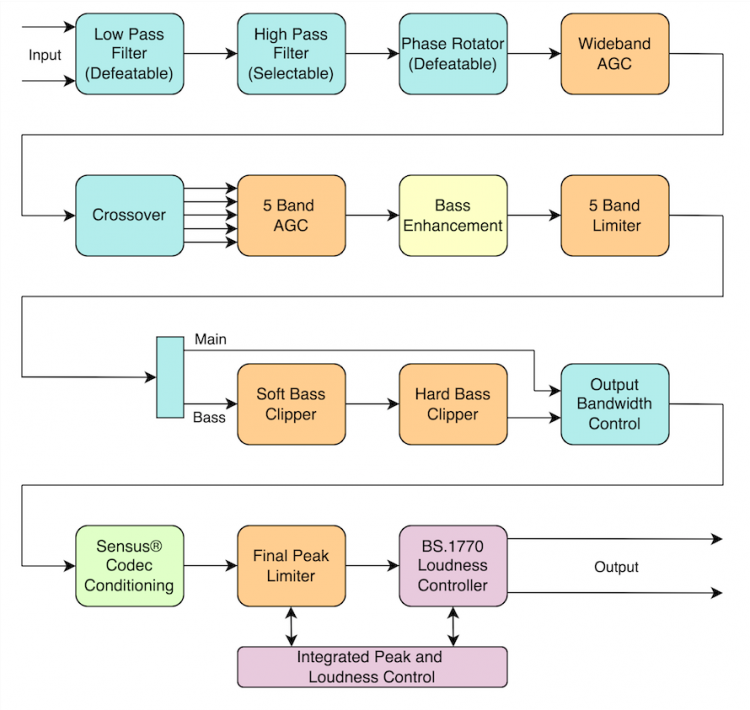Omnia Forza Audio Processor
Omnia Forza breathes new life into the traditional five-band processor design, featuring all-new AGCs and multiband limiters that yield a consistent and polished audio signature without sounding overly processed.
€ 1.435,00
Excl. VAT
Ships in:
Omnia Forza Audio Processor
Omnia Forza breathes new life into the traditional five-band processor design, featuring all-new AGCs and multiband limiters that yield a consistent and polished audio signature without sounding overly processed.
As a software processor, Forza is delivered via a Docker container that can be hosted on-premises on a COTS (commercial off-the-shelf) server or cloud-hosted and offers all the advantages of virtualization.
From a usability standpoint, expertly crafted “launch point” presets and an intuitive yet powerful user interface empowers users of all skill levels and ensures instant sonic excellence for listeners. Central to Forza’s UI is the use of “smart controls” that seamlessly maintain harmony between “under the hood” controls and settings. Anyone can confidently drive Forza without a PhD in processing, while professionals will love its powerful simplicity in crafting their unique signature sound. An integrated, target-driven ITU-R BS.1770 loudness controller makes conforming to emerging loudness requirements a set-and-forget process.
Omnia Forza Features
- Legendary Omnia audio quality
- Wideband AGC, 5 bands of multiband AGC, 5 bands of multiband limiting, soft and hard bass clippers, and final peak limiter
- Comprehensive bass management controls
- LUFS target-driven ITU-R BS.1770 loudness controller for compliance with streaming platform requirements
- True Peak limiter
- Omnia’s highly regarded Sensus® conditioning for low bitrate streams
- Carefully crafted Omnia presets ensure great-sounding audio on all types of formats and programs
- “Smart Controls” combine the adjustment of multiple, interrelated parameters into a single knob or slider
- Innovative single-page GUI welcomes less-experienced users while still providing the tools processing experts expect and need
- Browser-based HTML5 UI works on any device, including Windows and MacOS computers and Android and iOS smartphones and tablets
Audio processing software isn’t a new idea, nor is it a totally new concept for Telos Alliance. But for the most part, software processors have historically been based upon existing hardware products, and often limited to a single deployment style. Forza breaks that tradition as a processor that was purpose-built as software and delivered as a Docker container, allowing it to take advantage of the many benefits of virtualization, either on-premises or cloud-hosted. An API is also available for custom OEM integration.
Sonically, Forza is the culmination and synthesis of decades of audio processing experience by the Omnia team. The basic processing structure itself - wideband AGC, five-band AGC, and five-band limiter - follows tradition, but the underlying algorithms are brand-new and employ some of the most advanced and unique approaches to processing we’ve ever conceived. The result is a sound that presents as consistent and polished, but at the same time, natural and seemingly unprocessed.
Forza makes its debut as a stereo processor optimized for HD, DRM, DAB, and in particular, streaming audio applications. The days of streaming audio living in the shadow of terrestrial broadcasting are over, and as stations report an ever-increasing number of listeners moving to online listening, proper audio processing becomes just as essential for this platform as for the FM signal.
Another shift in the radio industry is the presence of fewer “traditional” broadcast engineers who have learned at least the basics of audio processing throughout their careers. In many operations today, streaming audio is deployed and managed by a completely separate department from terrestrial broadcast. These engineers are likely to have much less processing experience, and the multi-layer, multi-page user interface with hundreds of individual adjustments that are appreciated (and even expected) by processing gurus might be intimidating.
A key design goal in Forza was to distill a complex system with hundreds of underlying parameters into a lean, high-level control set where the entire UI - including all meters and controls - is presented on a single HTML5 web page. To support this, we embraced the concept of goal-driven “smart controls” that make the kind of individual adjustments to multiple parameters that a processing expert would make, but with a single knob or slider.
Even the most inexperienced user can quickly and easily create a successful sound by choosing one of the carefully-crafted Omnia presets and adjusting one or two controls. Users with more advanced processing skills will find all the tools they need to create a unique sonic signature to meet their needs and expectations.
While “specifications” tend to be a hardware category (unit dimensions, power requirements, etc.), the information below is intended to provide basic operational guidance for software container deployment on a Linux Server.
- Cores needed per instance: 1 core (x86-64 V3, Haswell or later architecture)
- CPU speed requirement: 2 GHz
- Memory requirements: 256 MB RAM per instance
- Latency: 40ms typical; CPU speed, AoIP setup, and other factors will affect system latency
- Required Linux distribution: Ubuntu v20.04 (64 bit)




